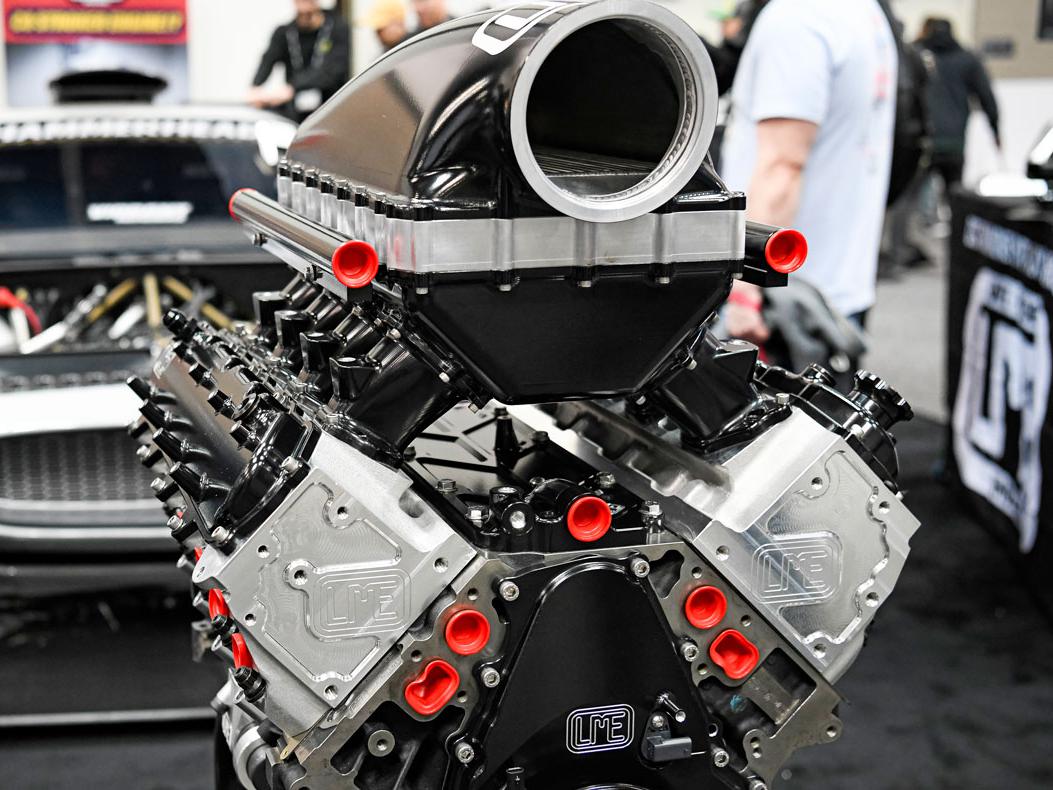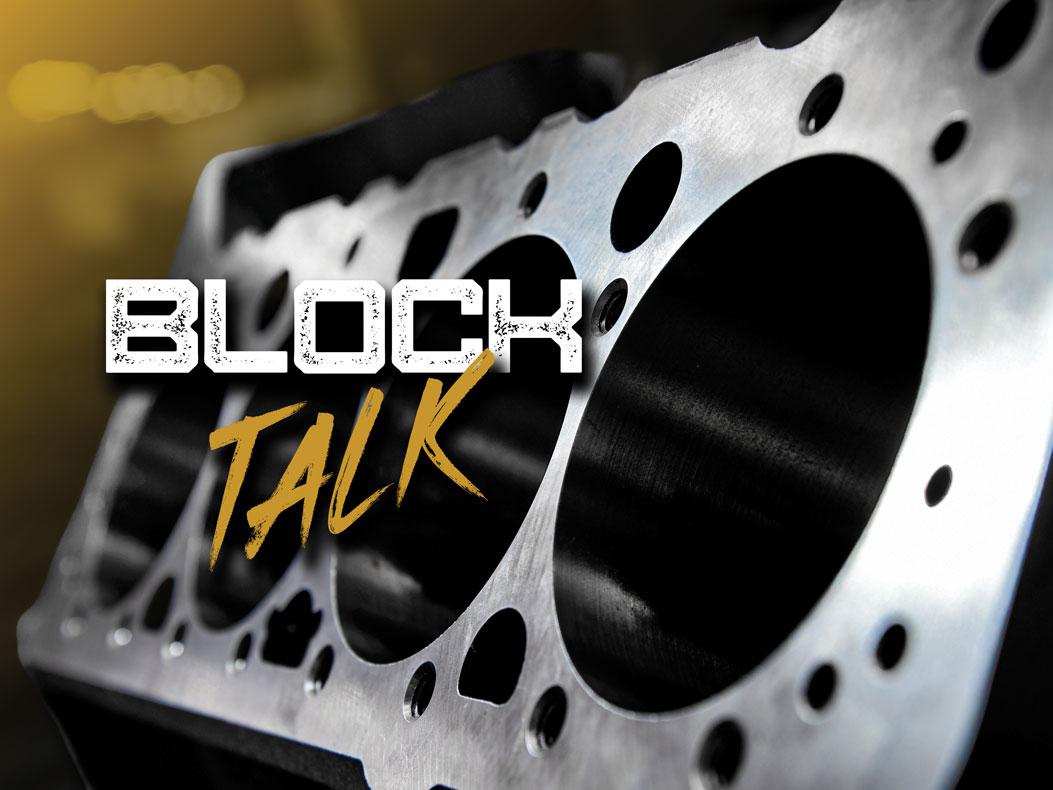Formula For Race Control: The F1 Safety Car
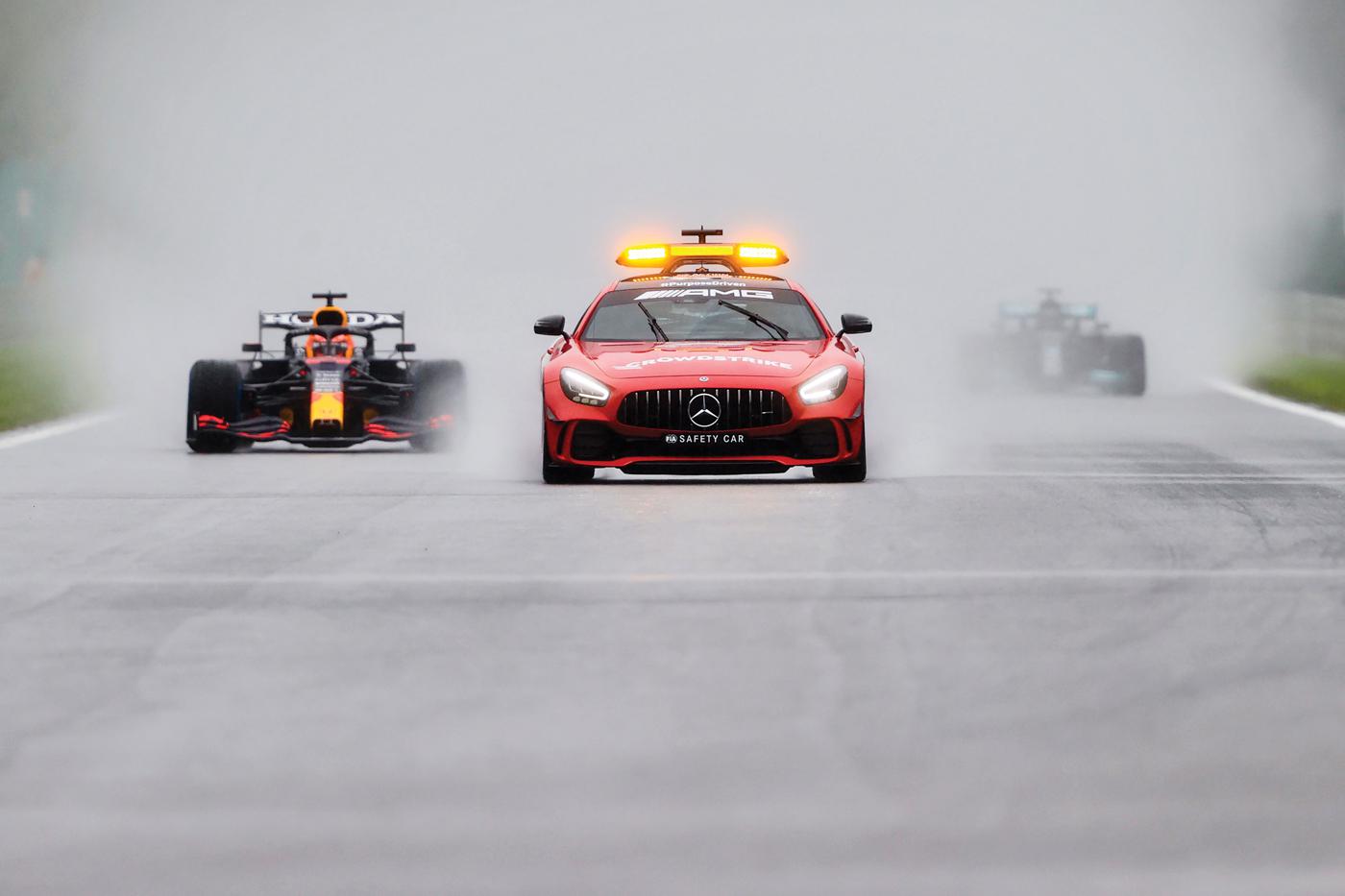
The Formula 1 safety car has proven not only an indispensable tool for race officials but also a popular icon among racing fans. September 23, 2023, marked 50 years since Eppie Wietzes’ Porsche led a 12-lap caution at the 1973 Canadian Grand Prix—recognized as the first official appearance of a safety car in Formula 1 racing. More than two decades would pass, however, before the safety car became a permanent F1 fixture, while its older ancestor, the Indianapolis pace car, evolved into a similar role.
After a fog-shrouded morning practice, and an hour-long delay due to pummeling rain, the 1973 Canadian Grand Prix was green-flagged on the rain-drenched pavement of Mosport Park. A blinding wall of spray limited on-track visibility and obscured a rapid shuffle in the running order, which continued as the surface dried and one car after another pitted to exchange rain tires for slicks.
Thirty-two laps in, François Cevert’s Tyrrell tangled with Jody Scheckter’s McLaren, flinging both cars into the Armco. Neither driver was seriously hurt, and the race continued under caution as emergency crews were dispatched to clear the wreckage.
It would be a caution like F1 fans had never seen before.
During practice at the Österreichring in August, F1 officials had tested a “pace car control system,” using a conspicuously striped and lettered Opel Commodore fitted with police-style lights and siren. A marshal waved a signal flag from the right-front window. In contrast, the yellow Porsche 914/6 deployed at Mosport on that late September Sunday appeared somewhat hastily cobbled: no lights, no graphics, just credentials taped to both doors and twin yellow flags flying from brackets on the rear bumper. But as the race cars lined up behind the Porsche, a Formula 1 tradition was born.
“The safety car is such a successful measure, and now so ingrained in motorsport culture, that I think we sometimes take for granted the enormous positive effect it has had,” F1 Race Director Niels Wittich wrote for F1 Insights. “It is one of the key tools at our disposal for dealing with hazards…related to incidents, weather, or people or vehicles on the track. The ability to quickly neutralize a race and ensure the security of…anyone who might be on the track…cannot be overestimated.”
“Its primary role is to ensure the safety of the track marshals and safety crews during an accident or other hazardous conditions,” confirmed Mark Webb, writing for Motor1.com.
At the same time, the safety car allows the race to continue, for drivers to keep up their rhythm, for tires and fluids to maintain their operating temperature—instantly ready for all-out speed once the green flag falls again.
“People tend to forget what it was like before,” added FIA Permanent Advisor Herbie Blash, also in F1 Insights. “What did we do when the rain was so heavy that it was difficult to continue? Nothing.”
The Grand Prix of Confusion
Also forgotten, however, seems to be the controversy that clouded the safety car’s debut. Accounts vary somewhat, but it appears that driver Egbert “Eppie” Wietzes pulled out in front of Howden Ganley’s Iso-Marlboro, mistakenly believing Ganley to be the race leader. This allowed several cars ahead of Ganley to complete an extra lap under yellow, while confused scorekeepers assumed Ganley was leading and adjusted their paperwork accordingly. When the checkered flag fell, Peter Revson (McLaren), Emerson Fittipaldi (Lotus), and Jackie Oliver (Shadow) were each quite certain they had won. Race officials reviewed lap charts—some water-damaged from the race’s soggy start—and debated for four hours before declaring Revson the winner, Fittipaldi second, and Oliver third. Jackie Stewart, who had already clinched the championship at Monza two weeks earlier, was scored fifth.
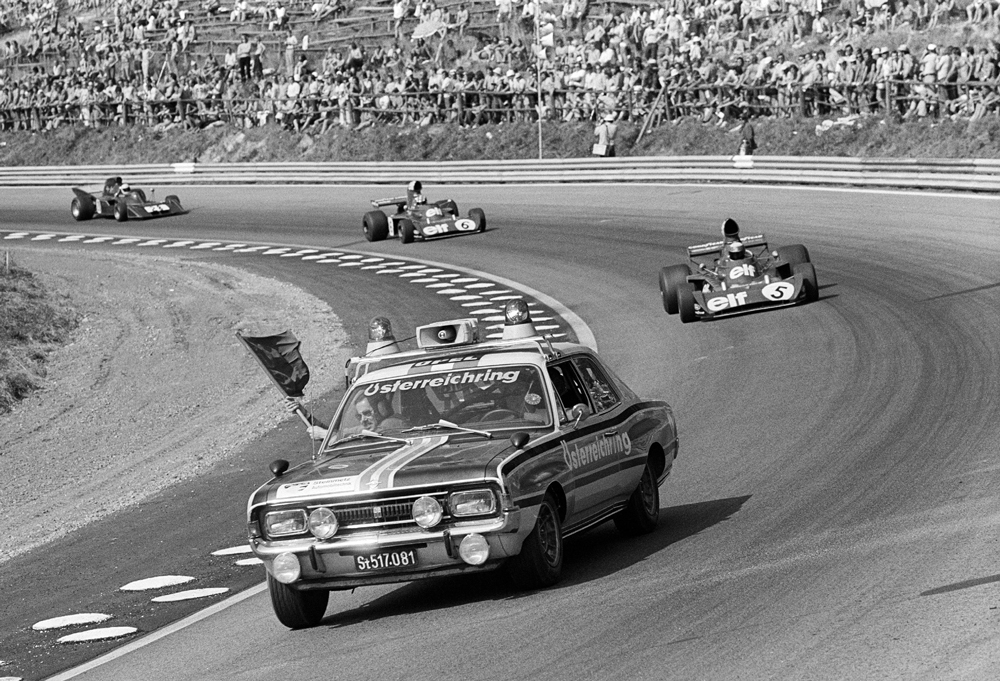
The 1973 Canadian GP has since been derided as “The Grand Prix of Confusion.” So it’s hardly surprising that for the following two decades safety cars appeared only sporadically at Formula 1 races. The Monaco Grand Prix was an early adopter, fielding a Porsche 911 in 1976, then upgrading to a Lamborghini Countach in 1981–1983. Then, after a nine-year hiatus, the safety car was revived when Ford offered an Escort RS Cosworth for trial runs at the 1992 British and French Grands Prix. These tests went well enough for FIA to approve safety cars for all race weekends in 1993.
Responsibility for the safety car was left to local race organizers, however, who complied only occasionally, and with an uneven assortment of vehicles. Patriotic pride seems to have influenced some of their choices: a Brazilian-built Fiat Tempra at Interlagos in 1993, followed by another Cosworth Escort at Silverstone; a Honda Prelude at Suzuka in 1994; an Argentine Renault Clio at Buenos Aires in 1996. No one could question the Lamborghini Diablo unleashed in Montreal in 1995; but far less fathomable was the Opel Vectra dispatched at Imola in 1994, which, after the Pedro Lamy-JJ Lehto shunt, navigated the circuit so slowly that Ayrton Senna pulled alongside several times and urged driver Max Angelelli to increase speed. (According to at least one source, Angelelli was trying not to overtax the Opel’s already fading brakes.) Senna suffered a fatal crash later in that same race.
Blash recalled how his “first encounter with the Safety Car in Race Control wasn’t without its difficulties.” It was the Renault Clio in Argentina. “It wasn’t ideal.”
Shortly after that, FIA took control of the situation, named Mercedes-Benz its official Safety Car Supplier, and saw that an adequately fast safety car was actually supplied for every race. Oliver Gavin, who had competed in Formulas 3 and 3000, was chosen as the permanent driver of a potent AMG C 36. F1 Race Director Charlie Whiting assumed responsibility for the safety car program in 1997, and “every year after that improvements were made,” said Blash, “to the car, to the technology inside it, and to the procedures.”
By that time, however, the Indy 500 pace car had been leading caution periods—essentially functioning as a safety car—for almost 20 years.
Origins In Indianapolis
As fans of the sport well know, F1 races are green-flagged from a standstill; normally the safety car has no role in the start of the race. “Standing starts are the default in Formula 1,” said Tom Wood, FIA Formula 1 World Championship media delegate, “and are used unless the race director decides there are specific circumstances, such as weather or track conditions, that necessitate a rolling start on safety or fairness grounds. Standing starts and restarts are also considered by the Commercial Rights Holder to be a more exciting spectacle for the fans, and a key moment of the race.”
Whereas what in the US is called a “pace car” was used originally, and exclusively, to enforce an orderly rolling start. According to Donald Davidson, recently retired as historian for the Indianapolis Motor Speedway, a pace car may have been used for this purpose as early as 1896, at a Narragansett Park, Rhode Island, competition for electric vehicles. That early experiment appears to have led nowhere, and maybe Carl G. Fisher, the visionary creator of the Indianapolis Motor Speedway, knew about it and maybe he didn’t. Fisher was certainly familiar with rolling starts from his bicycle-racing youth. And when 40 cars qualified for the first 500 in 1911, he foresaw the potential chaos of a multi-row standing start and turned to his bicycle racing experience for a solution.
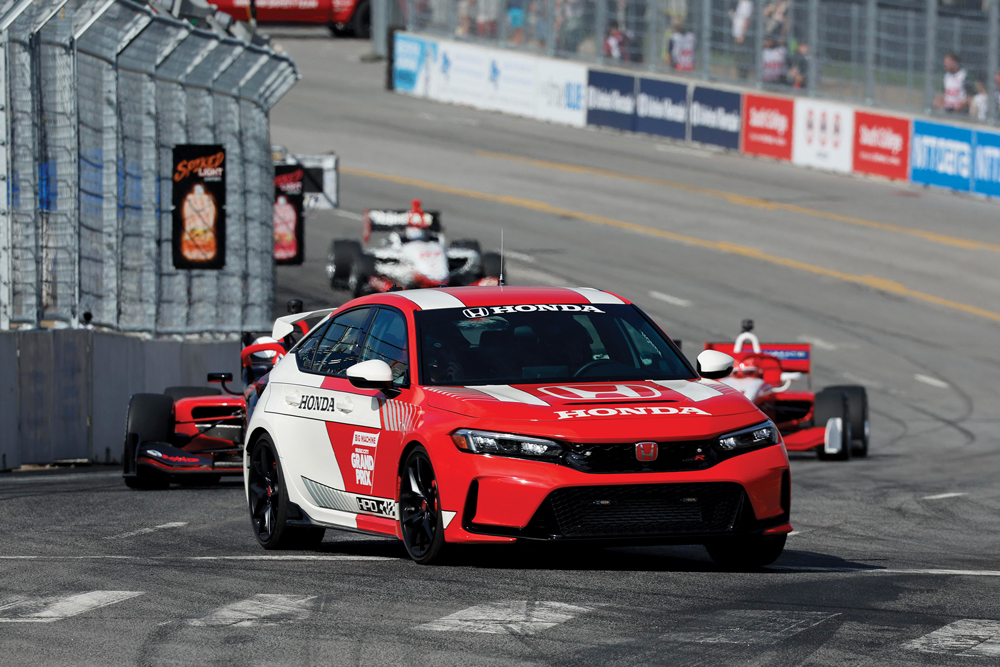
Fisher pitched his idea to the racers: Eight rows of five race cars would cruise behind a passenger car for one unscored lap; then the passenger car would pull over and release the rolling field to the flagman. The racers generally like the idea but nominated fellow racer Ralph DePalma to lead the field for one lap and then fall back into position. But Fisher insisted on starting the race himself, in a stock Stoddard-Dayton (for which Fisher was the Indianapolis dealer, and distributor for the state of Indiana). On the day before the race, Fisher practiced the rolling start, leading just 12 cars at first, gradually increasing speed and the number of cars while consulting with the racers between runs. On May 30, 1911, Fisher led his orderly start (albeit to a less-than-orderly race) and birthed a US tradition that has endured to this day.
Decades later, the pace car began returning to the track for re-starts—first in 1967, then in 1970, and again in 1973. And for the 1979 500, USAC decided to use the pace car to guide the racers through caution periods. So when Cliff Hucul stalled on lap 28, the remaining cars lined up behind a 5.0-liter Mustang driven by Jackie Stewart.
Already, however, it was becoming increasingly difficult to find catalogued production cars producing the minimum 200 horsepower required to safely lead championship-level race cars at speed. Stewart’s 5.0 had been rebuilt by Jack Roush to develop about 280 hp, exactly double its stock rating. With a few notable exceptions, Indy pace cars from the early 1970s into the early 1990s hid extensive modifications under their stock-appearing bodywork.
By the late 1990s—around the same time the FIA reached the same conclusion—the fledgling Indy Racing League was looking for an exclusive supplier that could guarantee an adequate level of performance. Series engine supplier Oldsmobile was a logical choice, transitioning to Chevrolet as GM allowed its oldest nameplate to fade into oblivion. From 2002, every Indy 500 pace car has been a Chevrolet Camaro or Corvette, although a Honda Civic Type R may pace other IndyCar-series races. “That’s based on our relationship with Chevrolet and Honda,” said Dave Furst, IndyCar’s vice president, Communications. Chevrolet also supplies Silverado pickups “used mostly for firefighting,” Furst added, although they may also assist the medical crew, whose primary vehicle is a Honda Pilot. (Furst called the Pilot the “safety car;” it would be the “medical car” in F1.)
Slicker Cars, Higher Tech
Meanwhile, the F1 safety car was upgraded to an even higher-performing CLK 55 for 1998–1999. When Gavin returned to Formula 3000 in 1999, Blash and Whiting recruited Bernd Mayländer, a former F1 driver who was then competing in the Porsche Carrera Cup and Supercup series.
Mayländer’s first safety car was the CL 55 that he drove at San Marino in 1999. F1 then deployed an SL 55 in 2001–2002, returned to a CLK 55 for 2003, and then chose a SLK 55 for 2004–2005, a CLK 63 for 2006–2007, and an SL 63 for 2008–2009. Succeeding the SL 63 for 2010 was the exotically gull-winged SLS; after SLS production ceased in 2014, F1 adopted its successor, the Mercedes-AMG GT, running the S variant in 2015–2017, and an R model in 2018–2021.
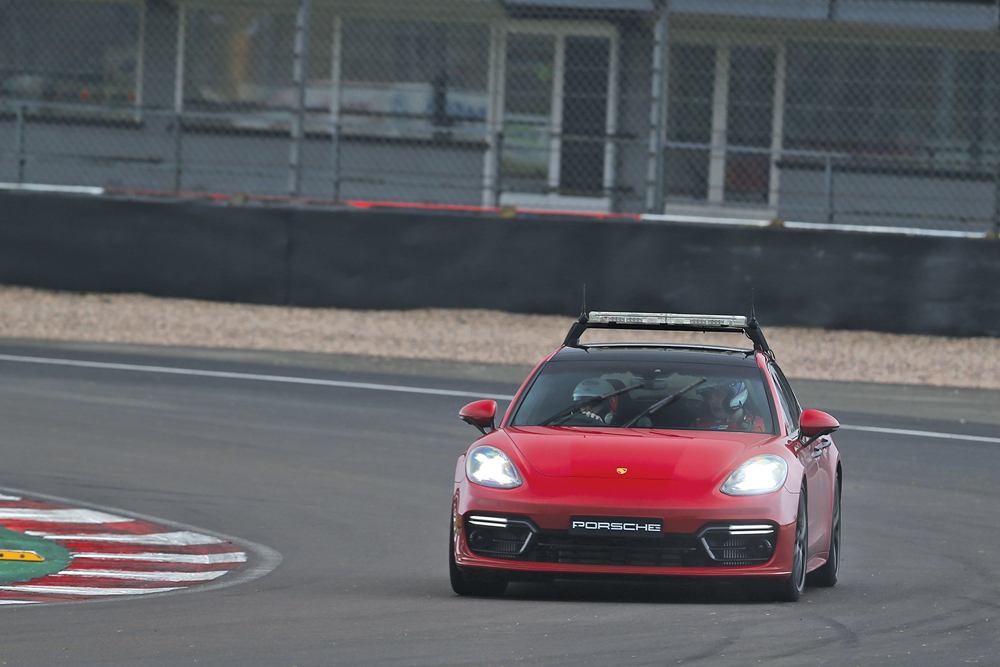
Through 2020, all of these cars were painted traditional Mercedes-Benz Grand Prix silver, but for its final season, the GT R was sensibly finished in a high-visibility red. Today Mayländer pilots either a Mercedes-AMG GT Black Series (still painted red), or since 2021, an Aston Martin Vantage (British Racing Green, of course).
On-board technology has evolved along with the cars. The CL 55 that Mayländer drove in 1999 had a built-in radio and a handheld backup unit. “And we were happy if the radio covered the full circuit,” said Mayländer, as quoted in FIA Insights. There was no GPS; Whiting pinpointed the car’s position using binoculars. Little changed until the late 2000s, and then a rapidly rising wave of advancing technology carried the safety car to where it is today.
Now, “GPS positioning helps us monitor everything,” Blash told FIA Insights. External cameras watch the action on the track, while telemetry allows engineers to monitor the health of the safety car itself. No fewer than four video screens display information inside the cockpit. The stock 10 1/2-inch infotainment screen, located above the center air vents, can be programmed to display virtual gauges, allowing Mayländer to monitor vehicle data such as transmission temperature. What looks like a second, larger inside mirror is in fact a screen connected to a video camera, expanding Mayländer’s view to the rear. Two additional screens, each at least as large as the factory screen, and mounted below and right of the air vents, respectively, provide a live feed of the race and pertinent information regarding any incidents on the track. Generally, co-driver Richard Darker watches those, allowing Mayländer to focus on driving. A medical warning light flashes if an on-track incident exceeds 20 G.
The safety car’s roof-top light bar flashes orange at each end to command attention, while its center section can light up the same red, yellow, or green as the safety marshal’s flags. This is controlled from an overhead console, while matching indicators light up at the center of the dash. A bright yellow knob, nestled among the center air vents, provides quick and convenient adjustment of the electronic traction control. The hardware that supports all this electronic wizardry occupies most of the AMG GT’s modest trunk.
Yet underneath all of this add-on equipment, the Mercedes-AMG remains absolutely showroom-stock, with all of its luxury features intact, or, as Mayländer puts it, it has “all of the regular buttons, and the function of all of the buttons is completely regular.”

In addition to the safety car, F1 now employs a medical car, a Mercedes-AMG C 63S wagon, which is “tuned up” and equipped with a marshaling system and multiple interior screens, much like Mayländer’s safety car. It, too, has a regular crew, although driver Bruno Correia and Dr. Ian Roberts are usually accompanied by a local physician. Their duties include training local medical personnel on FIA rescue and extraction procedures. Additionally, Correia is Mayländer’s understudy, ready to take the wheel of the safety car in case of illness or injury.
Roads Parallel and Divergent
Today, safety cars are used in most of the world’s premier race series. Just one example is the British Touring Car Championship (BTCC), which “introduced a safety car in the mid 1990’s,” said Anna Cowie, of the BTCC Media Team in Weybridge, Surrey, United Kingdom, “to neutralize the race while an incident is taken care of, rather than stopping the race. This has a few advantages, including the ability to clear any obstructions under safer conditions for all involved.”
Porsche is BTCC’s official safety car supplier, which ties in nicely with having the Carrera Cup as a support race. Although Porsche has provided Cayenne SUVs in the past, the current safety car is a stock Panamera GTS—more appropriate, perhaps, as a “saloon car” (in Britspeak) marshaling a saloon-car series. Cowie said the Panamera was chosen “for marketing and performance reasons” and because “it gives the Panamera a sporting presence.” Additionally, since 2018, BTCC has employed a Ford F-250 pickup—“carrying the very latest and best in cutting equipment”—as a rescue vehicle.
Like F1, BTCC favors standing starts wherever feasible, with rolling starts reserved, said Cowie, for when “weather conditions dictate it would be safer.”
That distinction aside, a case can be made that the Indy 500 pace car inspired the “pace car control system” tested in Austria 1973, and six years later assumed the caution-leading function of an F1 safety car, while FIA was still sorting out the details. Since the late 1990s, however, pace cars and safety cars have traveled parallel roads—with safety benefits for racers and race workers worldwide.
Thanks to primary sources Tom Wood of FIA, Anna Cowie of BTCC, and Dave Furst of IndyCar. Other sources include “TIMELINE: The 50-year history of the Safety Car’s Evolution in Formula 1,” by Nadim Bart-Williams, Formula 1.com, June 17, 2023; “Indy 500 Traditions: Pace Car Usage Originated in Indy,” by Donald Davidson, IndianapolisMotorSpeedway.com, May 17, 2020; “1973 Canadian Grand Prix—A race of confusion,” by René Fagnan, Motorsport.com, April 25, 2017; Forty Years of Stock Car Racing, revised edition (1990) by Gregory Lawrence Fielden; “My job in F1: The Safety Car driver,” by Erwin Jaeggi, Motorsport.com, May 6, 2022; Indy 500 Pace Cars, Publications International, 1996; “First-ever appearance of the Safety Car in F1,” Salracing.com, June 7, 2023; “1973 Canadian Grand Prix—Race Profile,” by Al Wolford, SportsCarDigest.com, February 5, 2015; “F1 Looks Back On 50 Years Of Safety Cars, Starting With The Porsche 914,” by Mark Webb, Motor1.com, June 22, 2023; and “FIA Insights: Celebrating 50 Years of the FIA Safety Car In Formula 1,” June 15, 2023.
 MEMBERSHIP LOGIN
MEMBERSHIP LOGIN JOIN PRI
JOIN PRI

